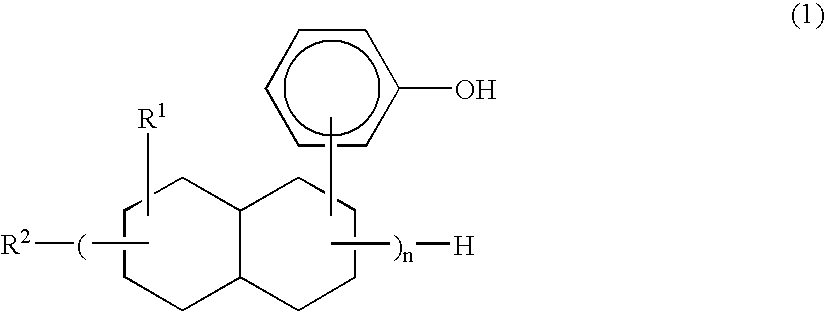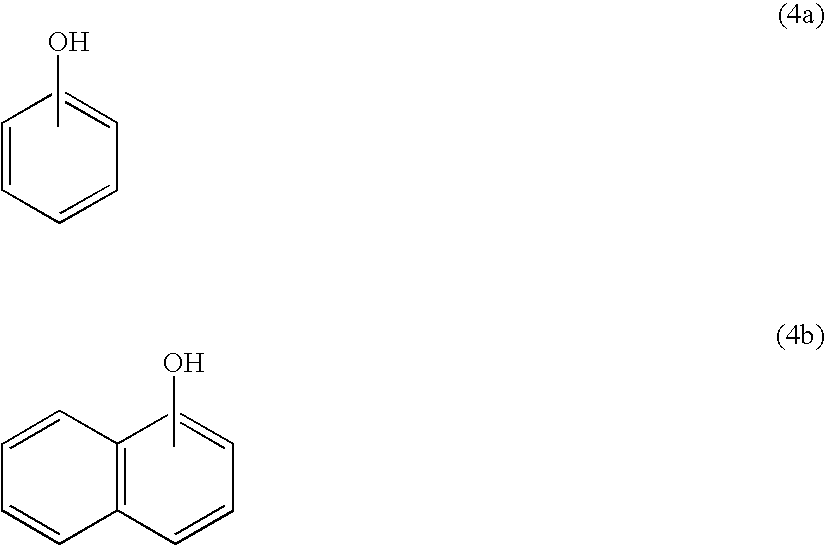Thermosetting Resin Composition, Resin Sheet and Resin Sheet for Insulated Substrate
a technology of resin composition and insulating layer, which is applied in the direction of synthetic resin layered products, record information storage, solid-state devices, etc., can solve the problems of difficulty in reducing the thickness of the insulating layer, affecting the processability and suitability of the material, and difficulty in aligning the top and back surfaces, etc., to achieve the effect of improving heat resistance and dimensional stability, good dimensional stability, and sufficient layered silica
- Summary
- Abstract
- Description
- Claims
- Application Information
AI Technical Summary
Benefits of technology
Problems solved by technology
Method used
Image
Examples
example 1
[0177]14.4 g of synthetic hectorite “Lucentite STN” and 197.2 g of DMF were mixed and stirred at normal temperature to complete homogeneity. Thereafter, 10.0 g of a bisphenol A epoxy resin “YD-8125” was introduced and stirred at normal temperature to obtain a completely homogeneous solution. Next, 23.5 g of an epoxy hardener comprised of a hydrophobic phenol compound “PP-1000-240” was introduced into the solution and stirred at normal temperature to complete homogeneity to prepare a thermosetting resin composition solution.
[0178]The above-obtained thermosetting resin composition solution was coated using an applicator onto a release-treated, transparent polyethylene terephthalate (PET) film (product name “PET5011 550”, 50 μm thick, product of Lintec Corp.) to a dry film thickness of 50 μm and dried in a GEER oven at 100° C. for 12 minutes to prepare a 200 mm×200 mm×50μm resin sheet which remained uncured. This uncured product of the resin sheet was then heated in a GEER oven at 170°...
example 4
[0180]50.0 g of a biphenyl epoxy resin “NC-3000H”, 47.0 g of an epoxy hardener “MEH-7851H”, 3.0 g of synthetic hectorite “Lucentite STN”, 0.3 g of triphenylphosphine and 150.0 g of DMF were charged into a beaker. After an hour of stirring by a stirrer, the beaker contents were degassed to obtain a resin / layered silicate solution. This resin / layered silicate solution was coated onto a polyethylene terephthalate sheet, desolvated and heated at 100° C. for 15 minutes to prepare a test sheet comprising an uncured product of the resin composition. The obtained test sheets were laminated to prepare a 1 mm thick, plate-shaped structure for use in the measurement of a melt viscosity of the uncured product. Further, the uncured test sheet and the laminate were cured by heating at 180° C. for 3 hours to prepare plate-shaped structures each comprising the resin composition and respectively measuring 100 μm and 2 mm in thickness.
example 5
[0181]48.0 g of a biphenyl epoxy resin “NC-3000H”, 45.0 g of an epoxy hardener “MEH-7851H”, 7.0 g of synthetic hectorite “Lucentite STN”, 0.3 g of triphenylphosphine and 186.0 g of DMF were charged into a beaker. After an hour of stirring by a stirrer, the beaker contents were degassed to obtain a resin / layered silicate solution. This resin / layered silicate solution was coated onto a polyethylene terephthalate sheet, desolvated and heated at 100° C. for 15 minutes to prepare a test sheet comprising an uncured product of the resin composition. The obtained test sheets were laminated to prepare a 1 mm thick, plate-shaped structure for use in the measurement of a melt viscosity of the uncured product. Further, the uncured test sheet and the laminate were cured by heating at 180° C. for 3 hours to prepare plate-shaped structures each comprising the resin composition and respectively measuring 100 μm and 2 mm in thickness.
PUM
| Property | Measurement | Unit |
|---|---|---|
| Temperature | aaaaa | aaaaa |
| Percent by mass | aaaaa | aaaaa |
| Percent by mass | aaaaa | aaaaa |
Abstract
Description
Claims
Application Information
 Login to View More
Login to View More - R&D
- Intellectual Property
- Life Sciences
- Materials
- Tech Scout
- Unparalleled Data Quality
- Higher Quality Content
- 60% Fewer Hallucinations
Browse by: Latest US Patents, China's latest patents, Technical Efficacy Thesaurus, Application Domain, Technology Topic, Popular Technical Reports.
© 2025 PatSnap. All rights reserved.Legal|Privacy policy|Modern Slavery Act Transparency Statement|Sitemap|About US| Contact US: help@patsnap.com



